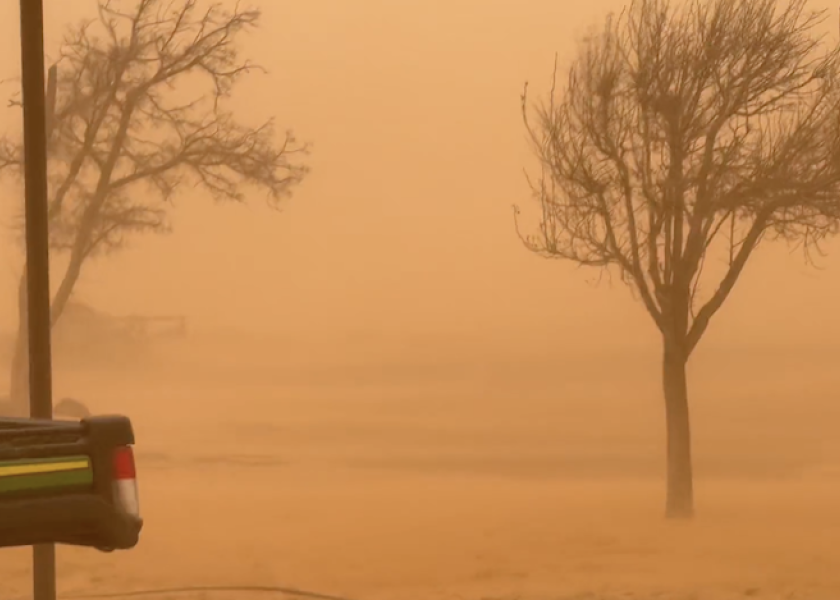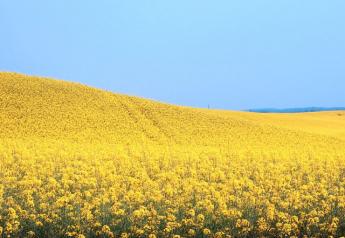'It Looks Like a War Zone': Texas Farmer Describes Wheat Crop Now Ravaged by Sunday's Derecho and Dust Storm

Scenes across Texas, Oklahoma and Kansas this week strongly resembled the Dust Bowl era of the 1930s. Winds topping 100 mph only added to the scars the two-year drought has etched into the area. Now, growers are dealing with a dryland wheat crop that could already see abandonment as high as 80%.
Photos and videos from the area portray scenes from Sunday’s storm. Quentin Shieldknight, a farmer in Spearman, Texas, says the area had already been ravaged by high winds this month. Sunday’s storm then finished off some of the wheat crop.
Trying times we are in right now. pic.twitter.com/GHaDqUUbXp — Jake (@zielke_jake) February 26, 2023
PEAK WIND GUSTS 2/26/2023 - Memphis, Texas takes the cake for highest wind yesterday by a long shot. I have seen my fair share of wind gusts near 100 mph before but have never seen one at 114 MPH until yesterday for our region.#txwx #okwx #nmwx #phwx @ABC7Amarillo @StormSearch7 pic.twitter.com/z4L9xMIv04 — Corbin Voges WX (@CorbinVogesWX) February 27, 2023
“I would say the dryland wheat's probably done,” Shieldknight told Farm Journal. “I would say the static electricity generated by that storm yesterday is probably going to be rather significant.”
That area of the Texas Panhandle sees an average rainfall total of 17 inches per year. However, it has seen only 12 inches of rain the past two years combined. “It's been a two-year drought for us where we haven't had a significant rain event,” he says. “What rains we did get got some crops up on the dryland fields, but it didn't sustain them. This northeast corner of the Texas Panhandle into the Oklahoma Panhandle into southwest Kansas, it almost looks like a ‘war zone,’ is what somebody called it. It's just so bad.”
This is unpleasant. pic.twitter.com/rqzBnFVIxJ — Brad Heffington 🌵🌵🏈 (@BradHeffington) February 26, 2023
Brad Heffington lives just north of Littlefield, Texas. He says Sunday's dust storm was as bad as he's seen in his 35-year farming career. He also is growing less optimistic about crop prospects this year, with his estimate of losses being at least 80% on dryland winter wheat. Heffington says it's getting so bad, even some of the irrigated wheat in his area has ben killed off by the dry and windy weather.
While crop losses could continue to mount, Shieldknight says adjusters will be assessing fields this week, but winter wheat abandonment on dryland could be as high as 80% in his area. That’s after Sunday’s weather was created, a picture that eerily resembled the Dust Bowl.
“Even before the storms built up behind all that wind, there was just significant dust in the air,” he says. “It was hot, extremely high winds. You had to be careful if you were in a high-profile vehicle. If you were driving and went around a corner or drove by a set of bins, you better be hanging onto the steering wheel pretty good. There were times where you couldn't see 10 feet in front of your face if you went by certain fields that were blowing.”
Almost paradise in west Texas 🥴
Top wind hit 78mph in Morton! pic.twitter.com/kmyYwsuiN9 — Railey Silhan (@RaileyKayBrown) February 27, 2023
What’s also scary to Shieldknight is how early the wind events started this year. Typically, March and April are the months that start producing high winds. That was the case last year, when a similar wind event took out much of the winter wheat crop in April. This year, the month of February produced two windstorms, with the major one hitting on Sunday.
Now, the Texas farmer is considering changing up his planting plans for this year, as the long-term weather prospects don’t look promising for the spring-planted crops.
“One thought in my mind last night was I might need to load up on some sorghum instead of more corn, because sorghum uses less water. The risk's there that we will have more days like this all the way into April or May,” he says. “It's going to change some crop plans from corn to low-use water crops, because that risk on corn could be significant. If our long-range weather forecast for July and August doesn’t change, I think guys have got to really start thinking about what crops do we need to roll back to and not have that risk out there.”
The sun is almost still visible pic.twitter.com/csTYDTFdpS — Mr Optimism🤔🌵 (@bwhite70) February 26, 2023
Shieldknight is also aware of some of the criticism around why farmers in the area don't plant more cover crops to help prevent dust storms like Sunday’s event. But the Texas farmer points out you need moisture to get any type of crop established, something that the area hasn’t really seen this year. Any cover crop or wheat that’s been planted in dryland is barely hanging on or was already killed off from drought and wind.
Farming in that area of the Plains is tough, which is why the area is also heavy into strip-tillage and other minimal-tillage practices to preserve any drop of moisture they can. But in years when it doesn’t rain, on fields that don’t have irrigation, there’s not much area farmers can do.
“We are in a unique place in the Texas Panhandle. You have to have a heck of a backbone and a strong faith in God, and it really takes a big one, because if it does not rain there is no chance you can get a crop up. There's just not a chance,” he says. “And we have windows where we get rain, and if you can't get a crop up in those windows, or planting at a time it doesn’t rain, it's nearly impossible. And so, most guys do the best job they can to leave cover on. That's why we try to plant winter wheat, or we try to leave our sorghum stalks or stuff on our dryland, because we can't raise dryland corn here.”
The weather hasn't only been devastating to wheat farmers, but also cattle producers who typically use those fields for grazing this time of year.







